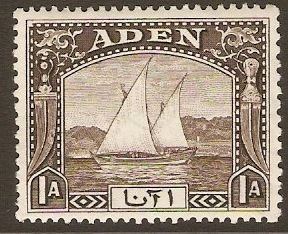 | ||
Aden is a city in southern Yemen. Aden's location made it a popular exchange port for mail passing between places around the Indian Ocean and Europe. When Captain S. B. Haines of the Indian Marine, the East India Company's navy, occupied Aden on 19 January 1839, mail services were immediately established in the settlement with a complement of two postal clerks and four letter carriers. An interim postmaster was appointed as early as June 1839. Mail is known to exist from 15 June 1839 although a regular postmaster was not appointed until 1857; one of the officials of the Political Agent or the civil surgeon performed the duties of postmaster for a small salary.
Contents
Stamps of British India
By the Indian Post Office Act of 1837 (Section XX) all private vessels were required to carry letters at prescribed rates for postage. A handstamp was applied to preadhesive ship letters in Aden; although these handstamps were used until 1867, examples are rarely seen.
The Aden Settlement used adhesive postage stamps of British India from 1 October 1854 until Aden became a crown colony on 1 April 1937. As an outpost of the British East Indian empire, Aden was supplied with India's first lithographed adhesives, which became available in Aden just as they were issued on the Indian mainland. Until 1857, the only Aden post office was in the Crater, later known as Aden Cantonment or Aden Camp. Mails were carried by camel to and from Steamer Point. In 1857 a Postmaster was appointed and the main post office was moved to new quarters at Steamer Point. Covers from Aden with the Indian lithographed stamps are rare.
Although these stamps did not have an Aden overprint, many of them may be recognised (even off cover) from the frequent use of the number 124 in postmarks, a number assigned to Aden as part of the Indian post office identification system. However, other numbers and letters also were used to identify the offices in Aden: these include 132, 125, A/125, B and B-22.
First stamps
In 1937, the Settlement was detached from India and became the Colony of Aden, a British Crown colony. Once Aden became a crown colony it received a series of pictorial stamps, produced by De La Rue & Co., inscribed "Aden".
George VI
In 1939, a new issue of stamps included a portrait of King George VI, but the sultans in Hadhramaut (whose territories had been under the British Aden Protectorate since the 1880s) objected to this, and so the British government issued separate stamps in 1942, but with the additional inscriptions Kathiri State of Seiyun and Qu'aiti State of Shihr and Mukalla (later Qu'aiti State in Hadhramaut), plus portraits of the respective sultans. All of these types were valid in Aden and the Aden Protectorate.
Queen Elizabeth II
Stamps inscribed Aden continued until 31 March 1965 when all were withdrawn.
